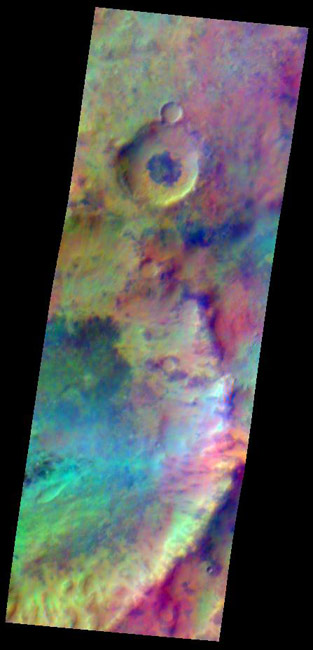NASA Probe Looks at Bright Side of Mars

An aging but dependable NASAprobe has tweaked its orbit around Mars to seek out warmer ground on the distant,red world.
NASA reckons the infraredcameras aboard the Mars Odyssey spacecraft will work better over regionsexposed to more sunlight, so it shifted the probe?s orbit in order to steer itscamera eyes away from the evening shade. The move took nearly eight months, ,but Odyssey?s infrared camera now peers onto the planet during the Martianafternoon, earlier than it has during most of its seven-year mission.
"The orbiteris now overhead at about 3:45 in the afternoon instead of 5 p.m., so theground is warmer and there is more thermal energy for the camera's infraredsensors to detect," said Jeffrey Plaut planetary scientist at NASA's JetPropulsion Laboratory (JPL) in Pasadena, Calif., in a statement.
The orbital switch increasesthe sensitivity of the camera, called the ThermalEmission Imaging System, to allow for better mapping of Martian minerals.It now senses infrared radiation from a warmer surface that is receiving moresunlight.
A warmer Martian target
Temperatures on Mars rangefrom as low as minus 195 degrees Fahrenheit (-125 degrees Celsius) near thepoles during the winter to 70 degrees Fahrenheit (20 degrees Celsius) at noonnear the equator. The average Martian temperature is about? minus 80 degreesFahrenheit (-60 degrees Celsius).
On Sept. 30, 2008, Odysseyfired its thrusters for six minutes, entering into a "drift"pattern that gradually changed its orbit and the time-of-day during which itwas over the planet. On June 9 of this year, the spacecraft fired the thrustersagain, this time for 5.5 minutes. The burn ended the drift pattern and lockedthe spacecraft into the new orbit, always above the planet in themid-afternoon.
Breaking space news, the latest updates on rocket launches, skywatching events and more!
"The maneuver wentexactly as planned," said JPL's Gaylon McSmith, Odyssey mission manager.
Afternoons on Mars
This is not the first timethe orbiter will see a sunnier side of Mars. Back in 2002, early in Odyssey'smission, it flew mid-afternoon passes over the planet and made importantdiscoveries of minerals, including salt deposits that were apparently leftbehind by large bodies of water when they evaporated.
"The new orbit means we can now get the type of high-quality data for therest of Mars that we got for 10 or 20 percent of the planet during those earlysix months," said Philip Christensen, an Arizona State University researcher who is principal investigatorfor Odyssey's Thermal Emission Imaging System.
The trade-off is that thenew orbit will put one of the spacecraft's other instruments out of commission.The gamma-ray detector, one of a suite of three instruments that sense shortlight waves and neutrons, must be shut down or risk overheating. In 2002, thesuite, called the Gamma Ray Spectrometer, made a dramatic discovery of largeareas of water-ice near the Martian surface. The gamma ray detector has alsomapped the global deposits of many elements, such as iron, silicon andpotassium.
NASA launched the MarsOdyssey orbiter in 2001. The solar-powered spacecraft arrived at the red planetabout a year later to begin its now seven-year Mars observation campaign.
? Video- Digging on Mars
? Video- Will Odyssey Get a Definitive Answer on Mars Water?
? SpecialReport: Odyssey Mission to Mars

Space.com is the premier source of space exploration, innovation and astronomy news, chronicling (and celebrating) humanity's ongoing expansion across the final frontier. Originally founded in 1999, Space.com is, and always has been, the passion of writers and editors who are space fans and also trained journalists. Our current news team consists of Editor-in-Chief Tariq Malik; Editor Hanneke Weitering, Senior Space Writer Mike Wall; Senior Writer Meghan Bartels; Senior Writer Chelsea Gohd, Senior Writer Tereza Pultarova and Staff Writer Alexander Cox, focusing on e-commerce. Senior Producer Steve Spaleta oversees our space videos, with Diana Whitcroft as our Social Media Editor.
